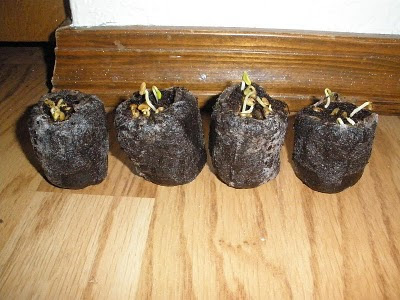A few years ago, at a restaurant in India, I had tasted a subzi called vegetable patiala. I vaguley remember that the curry was red and it had potli (dough pouches) filled with veggies or may be potato mixture. It looked very good, and tasted good too. Since then I have been looking for a recipe for vegetable patiala, but never found one.
So, today I decided to make my own version of vegetable patiala:) I made green potlies out of wheat floor and purred coriander, and cooked them in white gravy. Here is the recipe for vegetable patiala i.e. Paneer Potli in White Gravy.
For the Potlies:
3/4 Cup Wheat Flour
1/2 Cup Coriander or Spinach (for Green Color)
Salt to Taste
1 Teaspoon Oil
For Stuffing:
1/4 Cup Crumbled Paneer (home made works the best)
1/4 Cup Mixed Veggies (Carrots, Corn Kernels, Peas, Green Beans etc.)
Salt to taste
1/4 Teaspoon Ginger Garlic Paste
1/8th Teaspoon Sugar
For White Gravy:
1 Teaspoon Ghee (or Unsalted Butter)
1 Medium Onion
1 Clove Garlic, Finely Chopped
1 Teaspoon Ginger Grated (or Ginger Paste)
1/2 Cup Cashewnuts
So, today I decided to make my own version of vegetable patiala:) I made green potlies out of wheat floor and purred coriander, and cooked them in white gravy. Here is the recipe for vegetable patiala i.e. Paneer Potli in White Gravy.
For the Potlies:
3/4 Cup Wheat Flour
1/2 Cup Coriander or Spinach (for Green Color)
Salt to Taste
1 Teaspoon Oil
For Stuffing:
1/4 Cup Crumbled Paneer (home made works the best)
1/4 Cup Mixed Veggies (Carrots, Corn Kernels, Peas, Green Beans etc.)
Salt to taste
1/4 Teaspoon Ginger Garlic Paste
1/8th Teaspoon Sugar
For White Gravy:
1 Teaspoon Ghee (or Unsalted Butter)
1 Medium Onion
1 Clove Garlic, Finely Chopped
1 Teaspoon Ginger Grated (or Ginger Paste)
1/2 Cup Cashewnuts
1/4 Teaspoon White Pepper Powder (You can also use 2 Slit Green Chillies Instead)
1 Stick Cinnamon
2-3 Cloves
2-3 Cardmom Pods or, 1/8 Teaspoon Cardamom Powder
1 Stick Cinnamon
2-3 Cloves
2-3 Cardmom Pods or, 1/8 Teaspoon Cardamom Powder
A Pinch of Nutmeg Powder (Optional)
1/4 Cup Mixed Veggies (Optional)
1/4 Cup Mixed Veggies (Optional)
3/4 Cup Yogurt (You can use Ricotta if you like)
Chopped Coriander (or Parsley) for Garnishing
Method :
Stuffing:
Coarsley grind mix vegetables in a grinder and mix with all the stuffing ingredients. Keep aside. Note: If you are using fresh vegetables, then boil the vegetables until almost cooked and coarsley grind them.
Chopped Coriander (or Parsley) for Garnishing
Method :
Stuffing:
Coarsley grind mix vegetables in a grinder and mix with all the stuffing ingredients. Keep aside. Note: If you are using fresh vegetables, then boil the vegetables until almost cooked and coarsley grind them.
Polti:
Boil coriander in 1/2 cup water. When cooked, add to a grinder and make puree. Now add this puree, salt and oil to the floor and knead into firm dough. The dough should look green in color, so if neccessary add more coriander puree.
To make potlis, roll the dough into a 3 to 3/12 inch round (as thin as you can). Then place 1 spoon full of the stuffing mixture in the center of the round. Start folding the sides in the shape of a potli (or any other shape you like). The potli should be tight enough, and shouldn't open up while cooking in the gravy (apply cold water on the sides while folding if needed). Make as many potlis as you can with the flour and keep aside the remaining stuffing mixture.
Now steam the potlis for about 10 minutes in a dhokla vessel or a bamboo steamer or in a pressure cooker, with the whistle removed. Once the potlis are cooked, take them out of the vessel and keep aside.
For the Gravy:
Cut the onion in big pieces and boil it in 1-1/2 cup water. When cooked, drain blend in a mixer along with cashewnuts. (Add a little water in needed, you can add the same water in which the onlion was boiled).
Heat ghee in a pan and add cinnamon sticks, cloves, garlic, and cardamaom pods. (If using cardmom powder, don't add it now). When the ghee starts bubbeling, add the onion cashewnut paste, Ginger, Garlic and let it cook at medium heat for about 5-7 minutes. Add water if necessary and keep stirring occasionaly. Now add the remaining stuffing mixture, yougrt, white pepper powder (or green chilies), cardamom powder(If using) and veggies. Let it cook for 5 minutes and add the potlis. Make sure to not break the potlis while stirring the gravy. Let it simmer for 3-4 mintues and serve with naan or paratha.
Helpful Links:
 Yesterday, I transplated my pea plants out on the ground. Pea plants like cold weather, so it is actually advisible to plant them directly outdoor. I had to get rid of moss in my backyard, so I started the plants indoor.
Yesterday, I transplated my pea plants out on the ground. Pea plants like cold weather, so it is actually advisible to plant them directly outdoor. I had to get rid of moss in my backyard, so I started the plants indoor.












